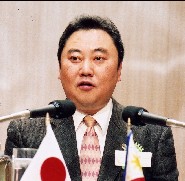��Internationalization of Haiku Poetry��
December 14th, 2005
��Hototogisu�� by Hototogisu Company
Chief Editor: Koutaro Inahata
 ��Haiku poetry has the image of being classic, but its history is not so old. ��Haikai�� was the poem popular in the Edo Period, composed of a series of syllables of 5-7-5, followed by 7-7, and by 5-7-5. The first syllables of 5-7-5 of Haikai are called ��Hakku (starting phrase)��. And it was Shiki Masaoka who shortened ��Hakku of Haikai�� and called it ��Haiku��.
��Haiku poetry has the image of being classic, but its history is not so old. ��Haikai�� was the poem popular in the Edo Period, composed of a series of syllables of 5-7-5, followed by 7-7, and by 5-7-5. The first syllables of 5-7-5 of Haikai are called ��Hakku (starting phrase)��. And it was Shiki Masaoka who shortened ��Hakku of Haikai�� and called it ��Haiku��.
��There are two characteristics in haiku if it is explained from the traditional haiku point of view.
��Haiku must be seventeen syllables of 5-7-5, and a season word is included. The Japanese words known as season words since olden days are ��Setsu-getsu-ka�� (��snow-moon-flower��). Snow is the symbol of winter, the moon is the symbol of autumn, and flower means cherry blossom, a typical word for spring.
��A season word is so called a word that represents a season. There are many season words, such as the names of flowers, weather, astronomy, and others, and among them, refined and beautiful words with a poetic flavor, adopted in the literary calendar, are specifically called ��Kidai�� (��seasonal theme��) in the world of traditional haiku. In haiku, February through April is spring, May through July is summer, August through October is autumn, and November through January is winter. Kidai is assigned for each season.
��In Japanese, there are unique Kidai. ��Kajikamu�� (��numb��) is a Kidai for winter. ��Nodokana�� (��balmy��) is Kidai for spring. And ��Suzushii�� (��cool��) is for summer. It is strange to say that summer is cool, but you feel cool better in hot summer. ��Sawayaka�� (��brisk��) is Kidai for autumn.
��In daily life, there is a balmy time when it is not spring. You may use a word, sawayaka, when it is not autumn. Originally, Japanese is the language of seasonal sense, which has many words used for each season.
Let me go to the internationalization of haiku.
��It is said that in the Edo Period, haiku was introduced to the West. Hakku of Haikai was introduced to those countries, and has developed uniquely in each country up to now. The internationalization of haiku is on going. There are haiku in English, haiku in French, German, and Chinese.
��In Chinese, it is written in Chinese characters in 5-7-5 syllables, and is called Kanhai. In English, it is a form of rhyme in 5-7-5 syllables. An international haiku symposium is held from time to time. These days there are participants from Korea. There are discussions about English haiku, because 5-7-5 syllables are too long, and some say it should be 2-3-2.
��Many foreigners are interested in haiku, but frankly speaking it will be difficult to internationalize haiku itself. It may be developed as a kind of literature of short poem form under the national culture of respective countries, but it will be difficult to internationalize haiku itself.
��For instance, a haiku by Basho Matsuo, ��Old pond�ġ�a frog leaps in water��s sound��, is translated into many languages around the world. With English only, there are several versions of translation. If you recite it you will understand the meaning, but the unique sound of reciting in Japanese will not be conveyed. It is important to listen to haiku in Japanese.
��You come across extreme scenes of translating any Japanese words to Western language, leaving particles only in Japanese. I hope that Japanese language is respected, and unnecessary translation into foreign language is to be avoided. It seems that present Japan is in the process of Westernization rather than internationalization. Before international exchanges, as a Japanese we need to learn beautiful Japanese language.
��I don��t say that all of you should compose haiku, but wish that you feel the mother tongue of Japanese through haiku. Haiku is not just language, but it is connected to the whole culture.